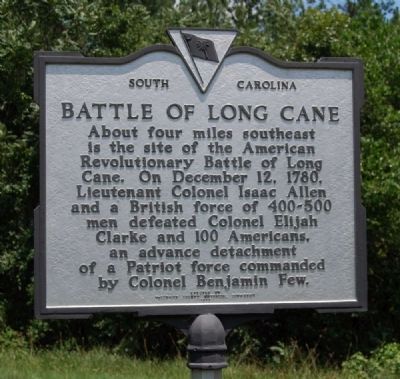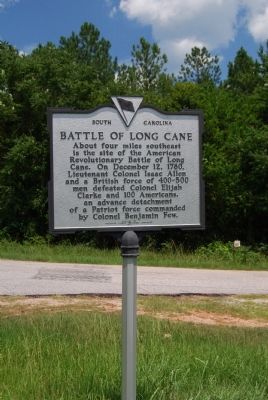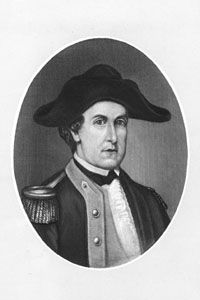Near McCormick in McCormick County, South Carolina — The American South (South Atlantic)
Battle of Long Cane
About four miles southeast is the site of the American Revolutionary Battle of Long Cane. On December 12, 1780, Lieutenant Colonel Isaac Allen and a British force of 400-500 men defeated Colonel Elijah Clarke and 100 Americans, an advanced detachment of a Patriot force commanded by Colonel Benjamin Few.
Erected 1977 by McCormick County Historical Commission. (Marker Number 33-7.)
Topics and series. This historical marker is listed in these topic lists: Military • War, US Revolutionary. In addition, it is included in the South Carolina, McCormick County Historical Commission series list. A significant historical date for this entry is December 12, 1780.
Location. 34° 1.925′ N, 82° 23.648′ W. Marker is near McCormick, South Carolina, in McCormick County. Marker is at the intersection of State Highway 28 and Old Charleston Road (Local Road 38), on the left when traveling south on State Highway 28. Touch for map. Marker is in this post office area: Troy SC 29848, United States of America. Touch for directions.
Other nearby markers. At least 8 other markers are within 6 miles of this marker, measured as the crow flies. Mulberry A.M.E. Church (approx. 3.7 miles away); Birthplace of Calhoun (approx. 3.7 miles away); Long Canes Massacre (approx. 4.1 miles away); Parsons Mountain World War II Memorial (approx. 5 miles away); Parsons Mountain (approx. 5 miles away); Constitution Tree (approx. 5 miles away); De La Howe Hall (approx. 5.4 miles away); John De La Howe / John De La Howe School (approx. 5.4 miles away).
Also see . . . Long Cane. What: 12 Dec 1780, Col. Clarke vs. Lt. Col. Allen, battle. (Submitted on December 7, 2009, by Brian Scott of Anderson, South Carolina.)
Additional commentary.
1. Battle of Long Cane
Date: December 12, 1780
Location: Near Troy, McCormick County
Commanders: Colonels Elijah Clarke, James McCall; Col. John H. Gruger
Casualties: American -- 14k, 7w; British -- unknown
The British stronghold at Ninety Six was the only post that had remained unmolested by the Patriots. The commander there, Col. John H. Cruger, learned that some of Sumter's officers who were with him at Blackstock's Ford were preparing to move against the fortification. Colonels Elijah Clarke and James McCall joined up with Col. Benjamin Few of Georgia and marched towards the Long Cane Settlement (about 30 miles southwest of Ninety Six), where they hoped to arouse the Patriot settlements of the populace and gain some new recruits to the cause. The settlement had been the victim of a Cherokee Indian attack in which 150 settlers were murdered.
To counter the Patriots' move, Colonel Cruger sent Col. Isaac Allen with about 450 Redcoats and Loyalists towards the American camp. Colonel Few, with about the same number, set out an advance force of about 00 to meet the enemy. initially the British were repulsed but although the main body of Patriots was in reserve, both Clarke and McCall were wounded early in the battle and the American forces fled in confusion. The British dragoons charged, inflicting deadly blows as they advanced. Colonel Few failed to bring up the main body and instead ordered a full retreat. (Source: South Carolina's Revolutionary War Battlefields: A Tour Guide (2002), R.L. Barbour, pages 71-72)
— Submitted November 14, 2008, by Brian Scott of Anderson, South Carolina.
2. Battle of Long Cane
Some of the militia who fought with Sumter at the Blackstocks joined Colonels Clarke and Few of Georgia, and marched to the Long Cane settlement. They intended to encourage the people there to join the Patriot cause, and eventually raise enough men to attack the fort at Ninety Six.
Lieutenant Colonel John Harris Cruger was the commander of the fort at Ninety
Six, and when he learned of the plans of the Patriot militia, he dispatched Lieutenant Colonel Isaac Allen to put down the militia. Colonel Allen moved to White Hall where the partisans had been camped, but only found an old campsite. He continued to search, but he did not find any partisans at all. Ironically Allen had camped only three miles from the partisan's camp. When he sent out foragers they bumped into a patrol sent out by Clarke. After a brief skirmish the partisans drove the foragers back, only to discover the Loyalist camp. Clarke and McCall engaged the Loyalist camp and sent back a message to Colonel Few to bring up his main force.
The partisans thought that only the Loyalist militia was present, and did not know of the Provincials under Allen. Allen had his men from on the other side of a hill, so as not to be seen. Clarke had his men tie their horses up within 100 yards of the Loyalist force, and then moved to engage the militia. When they were within forty yards of the Provincials, Clarke discovered the trap. He knew he was outnumbered and sent another message to Colonel Few, urging him to hurry. Clarke was seriously wounded in the shoulder and taken from the field. McCall and Lindsay were also wounded, and Lindsay lay where he fell. A Loyalist Captain named Long ran forward and cut off Lindsay's right hand.
When the Provincials charged with their bayonets the Patriots had enough, and retreated. Allen threw Dunlap's mounted militia into the battle, and the Patriots fled. As the man made it back to their camp and told colonel Few what was charging after them, he retreated, leaving six wagons and thirty head of cattle to be captured by the British. (Source: Nothing but Blood and Slaughter: The Revolutionary War in the Carolinas, Volume II: 1780 by Patrick O'Kelley (2004), pgs 382-383.)
— Submitted December 8, 2009, by Brian Scott of Anderson, South Carolina.
3. Benjamin Few
by L.D. Carmen, M.D.
Benjamin Few, Colonel of Richmond County militia during the Revolutionary War and one of the most active partisan officers of Georgia in that war, was born in 1744 at the "Three Sisters" plantation, near Hickory, Baltimore now Harford County, Maryland. He was the eldest son of William Few, Sr. and Mary Wheeler, deriving his given name from his maternal grandfather, Benjamin Wheeler.
In the fall of 1758 when Benjamin was fourteen years old, his father removed his family from the tobacco lands on Deer Creek in Northern Maryland to the frontier forests of North Carolina on the Eno River in Orange County, and here the boys of the family were inducted into the wielding of the axe to clear the wilderness, a new occupation, as the family chronicles record the blistered hands and strained muscles engendered by this unwonted task.
Here in North Carolina, outside of a short period at a country school, Benjamin assisted his father on the farm and at a saw and grist mill on the banks of the Eno, and here it was that he courted and won his wife, Rachel Wiley.
Ten years of peace the Fews spent in this frontier settlement, ten years of work and then the years of peaceful work were succeeded by the three years of the so-called War of the Regulators against the oppressive acts of the Colonial officers, who sought to enrich themselves at the expense of the people, and ending in the battle of Alamance, May 16, 1771, where the Regulators, poorly led and equipped, were defeated by the artillery and muskets of the British under General William Tryon, the royal governor, who bore the sobriquet of the Great Wolf of North Carolina.
The day after the battle James Few, Captain of the Regulators, the younger brother of Benjamin, refusing to take the oath of allegiance, was hanged at the head of the British camp, the first martyr in the cause of American independence. A few days after, the farm of the father, "a man dangerous to the State," according to the Governor's view-point, was overrun and the cattle and horses of the British driven in the fields to destroy the growing crops.
There is no positive evidence that Benjamin participated in the battle of Alamance, but it is believed that he was one of those who fought and escaped capture. His father was a sympathizer with the cause, and in 1768 was one of the bondsmen of Herman Husbands, the erstwhile leader of the Regulators, and Benjamin Few was not the kind of man to have remained peaceably at home when such an occasion offered. Certain it is that a few months after this battle, six more Regulators having been executed, the Few family, deeming North Carolina a dangerous place for longer residence, removed to the Quaker settlement in St. Paul's Parish, Georgia, near Wrightsboro, and the cruel execution of James Few was not calculated to make any of the family espouse the British cause in the sorrowful yet glorious years that followed.
The Revolution finds every male Few in arms: the aged father, William Few, Sr., according to the statement of his grandson, Rev. Ignatius A. Few, a Colonel in the Commissary Department; Benjamin, the subject of this sketch, Colonel of militia; his brother, William Few, Jr., Lieutenant Colonel of militia, had a distinguished career elsewhere recorded in this work; and the youngest brother, Ignatius Few, Lieutenant, Captain and Brevet Major of dragoons in the Continental Army.
The two brothers-in-law of Benjamin, Rhesa Howard, husband of Hannah Few, and Colonel Greenberry Lee, husband of Elizabeth Few, were also actively engaged.
The Revolutionary records of the State of Georgia having been nearly all destroyed, it is a somewhat difficult matter to follow the career of Benjamin Few through all the years of conflict. His earliest recorded action was not at the time deemed a creditable one. The patriots of Georgia had their hands full with the British and the Tories and did not want the horrors of an Indian warfare as well, so that it was but natural that the following, signed by Governor A. Bulloch, should appear under date of May 16, 1776, as part of orders to Captain Wm. McIntosh: "And as there has been information made of the murder of an Indian by one Few and a party of men under his command, you are therefore ordered to use your utmost efforts to apprehend the said Few and to bring him to Savannah, and at all times to do whatever may be in your power to prevent the murder of any Indian in the Back Country." But when Benjamin Few went to Savannah he went with the militia of Richmond County at his back.
Under the act of the Georgia Legislature of March 1, 1778, he was one of the Commissioners from the county of Richmond for the sale of the confiscated estates of Tories or those attained of treason. The members of this committee were especially obnoxious to the British and those caught were hanged.
Colonel Few was with the troops that marched against but failed to meet the British General Prevost in his attempt to take Savannah from Florida, and was a member of the unfortunate St. Augustine expedition in the spring of 1778, planned in retaliation for Prevost's campaign. After the capture of Savannah by the British in December, 1778, the whole patriot force in the State of Georgia consisted of the militia of the upper three counties; the militia of Richmond being under the command of Benjamin Few. He successfully resisted the attack of the British under Brown and McGirth upon the patriot camp in Burke County, on their way to Augusta, this constituting the first successful engagement against the enemy on Georgia soil, and shortly afterward he defeated and dispersed a large body of the Creek Indians inspired by the British agent Tate upon the Ogeechee River. This last affair was after the Georgia militia had been driven into South Carolina, not having been strong enough to resist the capture of Augusta by Colonel Campbell, January 31, 1779, and the Georgia Gazelle of February 15, 1779, a Tory paper, had gleefully announced the departure from Georgia of "a villainous tribe of plunderers under the celebrated horse thief, Captain Few."
It is not to be wondered at that the name of "Benjamin Few, Rebel Officer, Richmond," appeared in the historic black list promulgated by the British Governor, Wright, and that the Georgia Gazette of March 14, 1782, the Tory paper previously noted, printed within the British lines, further announced that "A Georgia Parole" [hanging] had been reserved for the "virtuous Few."
During the summer of 1779 Colonels Few, Twiggs and Jones were hanging around the outposts of the enemy, cutting off supplies and exerting themselves when opportunity offered. In December 1779, Colonels Few and Twiggs commanded the Georgia militia at the unsuccessful siege of Savannah. Here Pulaski received his mortal wound and was carried from the field by some of Colonel Few's men, but otherwise the militia did not distinguish themselves in the battle.
June 1780, finds Colonel Few in Hillsboro, North Carolina, his former home, on his way with the men of Richmond to join the Southern army. In December 1780, he was at the battle of Long Cane Creek, South Carolina, and here was criticised for not properly bringing his men into action, more of a surprise as "he had previously given evidence of good conduct."
It would hardly be profitable to follow him and the varying fortunes of the Southern army, so long unfortunate, to the end of the war.
One anecdote of his Revolutionary life has come down hitherto unrecorded through the years. When the British had overrun the entire State of Georgia, and lukewarm patriots, unable to remove their families from the State, were hurrying homeward and taking the oath of allegiance to George III, Benjamin Few, unable to remove his family, said that "he would leave them with the God of battles." When he did return after the war was over, like the other Georgia patriots, he returned to a ruined estate.
Colonel Few represented the county of Richmond in the first Georgia Legislature after the treaty of peace, and was a Justice in this county in 1783. He acquired a headright in Wilkes County about 1784, but spent most of his time on his farm on Germany Creek, Columbia County. He removed from Columbia County, Georgia, to Alabama in 1803. The Land Records, American State Papers, note his transactions there in connection with some Spanish grants, and there he died in 1805. He and his wife are buried in the neighborhood of the Nanna Hubba Bluffs on the Tombigbee River.
He left two sons, William and Thomas. Dr. James E. Dickey, President of Emory College, Georgia, is a descendant of the latter.
In personal appearance Colonel Few was about five feet ten inches high, stout and powerfully muscled, bold, bluff, kindhearted and magnanimous. He was a friend of the fatherless, as William and Sarah Few, the children of his murdered brother James, were reared in his family.
Feared and abused by his enemies, British and Tories, he was idolized by his soldiers; plain-spoken, brave and patriotic, a manly man, a soldier of many battles, he gave to Georgia, in times of peril, the years of his manhood. (Source: Men of Mark in Georgia: A Complete and Elaborate History of the State From its Settlement to the Present Time, Chiefly Told in Biographies and Autobiographies of the Most Eminent Men of Each Period of Georgia's Progress and Development, Volume 1 by William J. Northen (1906), pgs 75-80.)
— Submitted November 25, 2009, by Brian Scott of Anderson, South Carolina.
Credits. This page was last revised on February 14, 2024. It was originally submitted on July 21, 2008, by Brian Scott of Anderson, South Carolina. This page has been viewed 5,823 times since then and 207 times this year. Last updated on February 13, 2024, by Bob Britt of Due West, South Carolina. Photos: 1. submitted on November 24, 2009, by Brian Scott of Anderson, South Carolina. 2. submitted on July 21, 2008, by Brian Scott of Anderson, South Carolina. 3. submitted on October 16, 2009, by Brian Scott of Anderson, South Carolina. • Bernard Fisher was the editor who published this page.


